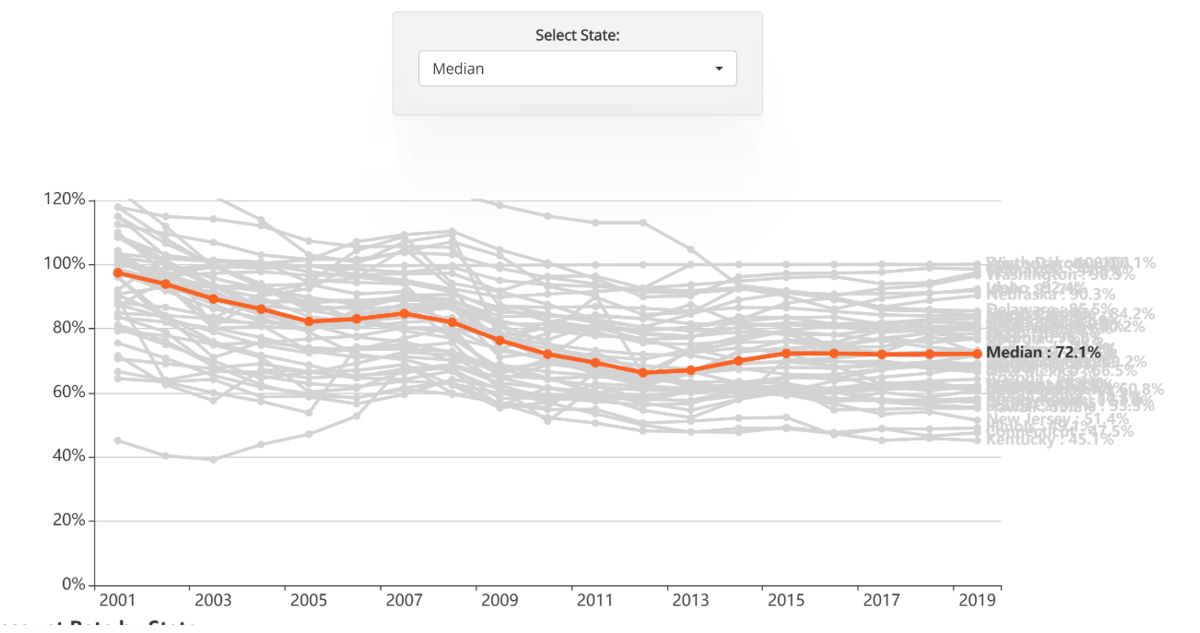

Finance
What Does Funding Mean On Our Florida
Published: December 21, 2023
Discover what funding means for the finance industry in Florida and how it can impact your financial decisions.
(Many of the links in this article redirect to a specific reviewed product. Your purchase of these products through affiliate links helps to generate commission for LiveWell, at no extra cost. Learn more)
Table of Contents
- Introduction
- Overview of Funding in Florida
- Sources of Funding in Florida
- State Funding
- Federal Funding
- Local Funding
- Types of Funding in Florida
- Education Funding
- Healthcare Funding
- Transportation Funding
- Housing Funding
- Environmental Funding
- Economic Development Funding
- Challenges and Issues with Funding in Florida
- Funding Disparities
- Budget Limitations
- Accountability and Transparency
- Conclusion
Introduction
Welcome to our comprehensive guide on funding in Florida! In this article, we will explore the world of finance and funding in the Sunshine State, highlighting the various sources and types of funding available. Florida, known for its diverse economy and thriving industries, relies on a robust funding system to support its infrastructure, education, healthcare, and more. Understanding the intricacies of funding in Florida is crucial, as it impacts the overall well-being of the state’s residents and the development of its communities.
Whether you are a Florida resident, a business owner, a student, or simply interested in understanding the financial landscape of the state, this article will provide you with valuable insights and information. We will delve into the different sources of funding in Florida, such as state, federal, and local funding, and discuss the various areas that receive funding, including education, healthcare, transportation, housing, environmental initiatives, and economic development.
As we explore the funding landscape, we will also address the challenges and issues associated with funding in Florida. These challenges range from funding disparities among different regions of the state to strict budget limitations and the need for increased accountability and transparency.
By the end of this guide, you will have a comprehensive understanding of the funding mechanisms in Florida and the impact they have on the state’s economy, infrastructure, and quality of life. So, let’s dive in and explore the fascinating world of funding in the beautiful state of Florida!
Overview of Funding in Florida
Florida, a state known for its vibrant economy and diverse industries, relies on a robust funding system to support its various needs. Funding plays a critical role in ensuring the development and maintenance of infrastructure, the delivery of essential services, and the overall well-being of the state’s residents.
One of the key aspects of funding in Florida is the allocation of resources from different sources. These sources include state funding, federal funding, and local funding. Each of these sources contributes to different areas of the state’s economy and public services.
State funding, as the name suggests, refers to the funds allocated by the state government of Florida. The state budget is designed to address various sectors, including education, healthcare, transportation, environmental initiatives, economic development, and more. State funding plays a vital role in addressing the unique needs and priorities of the state’s residents.
Federal funding is another significant component of the funding landscape in Florida. The federal government provides financial assistance to the state through grants, subsidies, and other funding programs. These funds support a range of initiatives, including infrastructure development, disaster relief efforts, research and development, social welfare programs, and more.
Local funding refers to the funds generated at the local level, such as through property taxes, sales taxes, and other revenue sources. These funds are primarily used to support the local infrastructure, public schools, law enforcement, and other community-specific needs. Local funding allows communities to address their unique priorities and invest in their own development.
With a diverse economy and varying needs across different regions, Florida receives funding for various sectors. Education funding is a top priority, as it ensures the quality of education and supports the development of future generations. Healthcare funding is crucial to providing accessible and affordable healthcare services to the state’s residents. Transportation funding supports the maintenance and expansion of transportation infrastructure, including roads, bridges, and public transportation systems. Housing funding helps address affordable housing needs in the state, ensuring that residents have access to safe and affordable homes. Environmental funding contributes to the preservation and conservation of Florida’s natural resources, including its unique ecosystems and wildlife. Lastly, economic development funding plays a crucial role in attracting businesses and supporting job creation, ultimately bolstering the state’s economy.
As we explore the funding landscape in Florida, it is essential to consider the challenges and issues associated with funding. Funding disparities among different regions of the state can create economic and social inequalities. Strict budget limitations may restrict the amount of funding available for essential services and programs. Moreover, ensuring accountability and transparency in the allocation of funds is crucial to maintaining public trust and ensuring effective utilization of resources.
In the subsequent sections, we will delve deeper into each type of funding in Florida, exploring the specific areas they support and the challenges they face. Funding is a complex and dynamic aspect of the state’s economy, and understanding its nuances is key to fostering sustainable growth and development.
Sources of Funding in Florida
Florida relies on a diverse range of funding sources to support its various needs and initiatives. These sources include state funding, federal funding, and local funding. Each of these sources contributes to the financial resources available to the state and plays a crucial role in supporting different sectors of the economy.
State Funding: The state of Florida allocates funding through its annual budget process. State funding is derived from various revenue streams, including taxes, fees, and other sources of income. The state budget is developed through a careful analysis of the state’s needs, priorities, and available resources. The funds are then allocated to various sectors such as education, healthcare, infrastructure, public safety, and environmental programs. State funding provides the foundation for addressing the unique needs of Florida’s residents and promoting economic growth.
Federal Funding: Florida receives a significant amount of funding from the federal government. This funding is provided through grants, subsidies, and other financial assistance programs. The federal government supports various sectors in Florida, including transportation infrastructure, healthcare services, education initiatives, environmental conservation, research and development, and disaster relief efforts. Federal funding plays a crucial role in augmenting the state’s resources and enabling it to undertake projects and programs that would otherwise be financially unfeasible.
Local Funding: Local funding is generated at the county and municipal levels and is primarily derived from sources such as property taxes, sales taxes, and revenue from other local fees and charges. Local funding allows communities to address their unique needs and invest in local infrastructure, public services, and community-driven initiatives. These funds are typically utilized for essential services such as public schools, law enforcement, road maintenance, parks and recreation, and community development projects. Local funding enables communities to have greater control over their financial resources and tailor their spending to meet specific local needs and priorities.
The combination of state, federal, and local funding sources provides a comprehensive financial framework for the state of Florida. These sources work together to ensure that funding is available for key sectors such as education, healthcare, transportation, housing, environmental initiatives, and economic development. The allocation of funds from these sources is guided by the state’s strategic priorities, community needs, and the overall well-being of its residents.
As we continue our exploration of funding in Florida, we will delve into the specific types of funding available in each sector and examine the impact and challenges associated with each source of funding. Understanding the different sources of funding is essential in comprehending the financial landscape of the state and how it supports the diverse needs of its population.
State Funding
State funding is a crucial component of the financial landscape in Florida. It represents the funds allocated by the state government to address the needs of its residents and support various sectors of the economy. The state budget plays a pivotal role in determining the allocation of funds and ensuring the effective utilization of resources.
State funding in Florida is derived from a variety of revenue sources, such as taxes, fees, and other income streams. These funds are then distributed across different sectors and programs based on the state’s priorities and budgetary considerations.
Education is one of the primary areas that receive state funding in Florida. The state government recognizes the importance of providing quality education to its residents and allocates a significant proportion of its budget to support public schools, colleges, and universities. State funding for education plays a crucial role in ensuring accessible and effective educational opportunities for students at all levels.
In addition to education, state funding is allocated to support healthcare initiatives in Florida. The state recognizes the importance of providing quality healthcare services to its residents and invests in programs that support healthcare access, research, and innovation. State funding for healthcare contributes to the development and maintenance of healthcare infrastructure, the provision of essential services, and the improvement of healthcare outcomes for the population.
Transportation infrastructure is another key area of focus for state funding in Florida. The state’s vast network of roads, bridges, and public transportation systems requires ongoing maintenance, expansion, and improvement. State funding helps address these needs, ensuring the safe and efficient movement of people, goods, and services across the state.
Housing is also a priority area for state funding. Affordable housing initiatives aim to address the housing needs of low-income individuals and families in Florida. State funding supports the development of affordable housing projects, rental assistance programs, and homeowner assistance programs to ensure that residents have access to safe and affordable housing options.
Environmental preservation and conservation receive state funding to protect Florida’s unique ecosystems, natural resources, and wildlife. The state recognizes the importance of safeguarding its natural treasures and invests in initiatives aimed at restoration, conservation, and sustainability. State funding supports efforts to combat climate change, protect endangered species, preserve natural habitats, and enhance environmental resilience.
Lastly, state funding plays a crucial role in promoting economic development in Florida. The state government invests in programs and initiatives that attract businesses, foster entrepreneurship, and create job opportunities. State-funded economic development efforts aim to diversify the state’s economy, drive innovation, and stimulate growth in key industries.
While state funding in Florida is essential for addressing the needs of its residents, there are challenges and limitations associated with it. The state government must balance competing priorities and allocate funds efficiently to achieve maximum impact. Budget limitations, revenue fluctuations, and fiscal constraints can pose challenges in meeting all funding demands. Additionally, ensuring accountability, transparency, and effective oversight in the allocation and utilization of state funding is crucial to maintain public trust and ensure optimal outcomes.
In the next section, we will explore another significant source of funding in Florida: federal funding. Understanding the dynamics and implications of federal funding is essential to comprehending the full scope of the financial landscape in the Sunshine State.
Federal Funding
Federal funding plays a significant role in supporting various sectors of the economy in Florida. The federal government provides financial assistance to the state through grants, subsidies, and other funding programs. This financial support helps address critical needs, stimulate economic growth, and advance key initiatives across the state.
Florida receives federal funding in various sectors, including transportation, healthcare, education, research and development, disaster relief, environmental conservation, and social welfare programs.
Transportation funding from the federal government helps Florida maintain and expand its transportation infrastructure. This includes funding for road construction and maintenance, bridge repairs, public transit systems, and airport improvements. These funds not only support the efficient movement of people and goods but also contribute to economic growth and job creation in the state.
Healthcare funding from the federal government is crucial to ensure accessible and affordable healthcare services for Floridians. The federal government provides funding for programs such as Medicaid, which helps low-income individuals and families receive necessary medical care. Additionally, federal funds support healthcare research, innovation, and the implementation of initiatives aimed at improving public health outcomes across the state.
Educational institutions in Florida benefit from federal funding, which supports various educational programs, initiatives, and research grants. These funds help enhance the quality of education, improve educational outcomes, and promote educational equity and access for students of all backgrounds. Federal funding also supports workforce development programs that equip Floridians with the skills and training needed to succeed in the evolving job market.
Research and development funding from the federal government fuels innovation and drives economic growth in Florida. Research institutions, universities, and businesses in the state receive federal grants to support cutting-edge research, technological advancements, and the commercialization of new discoveries. This funding plays a vital role in promoting scientific innovation, attracting talent, and fostering a robust research ecosystem in Florida.
Florida is susceptible to natural disasters, and federal funding for disaster relief is crucial in providing assistance during times of crisis. The federal government allocates funds for emergency response, recovery efforts, and rebuilding initiatives to help communities recover from hurricanes, floods, and other natural disasters. This funding aids in restoring infrastructure, supporting displaced individuals, and facilitating the overall recovery and resilience of affected communities.
Environmental funding from the federal government supports Florida’s efforts to preserve and protect its unique natural resources and ecosystems. Funds are allocated for conservation projects, environmental research, habitat restoration, and the management of national parks and wildlife refuges. These initiatives contribute to maintaining the state’s biodiversity and ecological health while promoting sustainable development.
Other federal funding programs in Florida address social welfare issues, including housing assistance, food security programs, and unemployment benefits. These programs provide critical aid to individuals and families in need, ensuring their basic needs are met and helping them navigate challenging times.
While federal funding brings significant benefits to Florida, it also presents challenges and considerations. Federal funding programs often come with specific guidelines, requirements, and reporting obligations. The state needs to navigate complex regulations and ensure compliance to access and effectively utilize these funds. Additionally, political dynamics, budget fluctuations, and shifts in federal priorities can impact the availability and continuity of federal funding.
In the next section, we will explore another crucial source of funding in Florida: local funding. Local revenue sources play an essential role in addressing community-specific needs and empowering local governments to make strategic investments.
Local Funding
Local funding is a vital source of financial resources for communities in Florida. It refers to the revenue generated at the county and municipal levels through taxes, fees, and other local revenue sources. This funding plays a crucial role in addressing community-specific needs and empowering local governments to make strategic investments.
One of the primary sources of local funding in Florida is property taxes. Property owners in the state contribute a portion of their property value as taxes, which are then used to fund various local initiatives. Property tax revenue is an essential source of funding for local governments and helps support a wide range of public services such as education, public safety, infrastructure maintenance, and community development projects.
Sales tax is another significant source of local funding in Florida. A portion of the sales tax collected on goods and services within a county or municipality goes directly to the local government. Sales tax revenue provides a flexible funding source that can be utilized to support a variety of community needs, including public services, economic development, and essential infrastructure improvements.
Local governments in Florida may also generate revenue from permits, fees, and licenses. These funds are typically associated with specific services or activities, such as building permits, business licenses, parking fees, and fines. The revenue generated from these sources helps offset the costs of providing services and enforcing regulations at the local level.
Furthermore, grants and donations from local businesses, philanthropic organizations, and individuals contribute to local funding. These contributions can support various community initiatives, such as scholarships, cultural programs, parks, and recreation facilities. Local governments often actively seek out partnerships and sponsorships to enhance their financial resources and support community-driven projects.
Local funding allows communities in Florida to address their unique needs and invest in areas that directly impact the quality of life for residents. Local governments have the flexibility to determine the allocation of funds based on their specific priorities and community feedback.
Communities utilize local funding to support various essential services, such as public schools, law enforcement, fire protection, and emergency services. Local funding also goes towards maintaining and improving local infrastructure, including roads, utilities, parks, and libraries. Additionally, funding is directed towards community development and revitalization efforts, affordable housing initiatives, and cultural and recreational programs that enrich the lives of residents.
While local funding provides a level of autonomy and allows communities to address their specific needs, it does come with its own set of challenges. The reliance on local revenue sources means that funding levels can vary significantly between communities, leading to disparities in resources and services. Communities with a higher tax base or greater economic activity may have more financial resources available compared to less affluent areas. Balancing the distribution of resources and ensuring equitable access to services can be a complex endeavor.
In the next sections, we will delve into different types of funding in Florida, exploring how these funding sources support specific sectors such as education, healthcare, transportation, housing, environmental initiatives, and economic development. Understanding the various types of funding is essential in comprehending the financial landscape of the state and its impact on the well-being of its residents.
Types of Funding in Florida
Funding in Florida encompasses various sectors and initiatives, ensuring the state’s development and the well-being of its residents. Let’s explore the different types of funding available in key areas of focus:
1. Education Funding: Education funding in Florida is crucial to provide high-quality education to students. This funding supports public schools, charter schools, colleges, and universities. It covers areas such as teacher salaries, instructional resources, infrastructure improvements, and special education programs.
2. Healthcare Funding: Healthcare funding is essential to provide accessible and affordable healthcare services. It supports healthcare facilities, community health centers, and programs that address public health concerns. This funding also helps support healthcare research, initiatives for underserved populations, and the implementation of new technologies and treatments.
3. Transportation Funding: Transportation funding in Florida ensures the maintenance and expansion of the state’s transportation infrastructure. It covers the construction and repair of roads, bridges, highways, and public transit systems. This funding also supports alternative transportation modes, such as biking and walking paths, as well as the development of intelligent transportation systems.
4. Housing Funding: Housing funding aims to address affordable housing needs in Florida. It supports the development of affordable housing units, rental assistance programs, and initiatives to combat homelessness. This funding helps ensure that residents have access to safe and affordable housing options.
5. Environmental Funding: Environmental funding is crucial to preserve and protect Florida’s unique natural resources. It covers initiatives for conservation, restoration of ecosystems, protection of wildlife, and the improvement of water quality. This funding also supports research and education programs related to environmental conservation and sustainability.
6. Economic Development Funding: Economic development funding plays a vital role in attracting businesses, promoting innovation, and creating job opportunities. It supports initiatives such as business incentives, workforce training programs, and infrastructure projects that contribute to economic growth and diversification in the state.
These types of funding interact with one another to meet the specific needs and priorities of Florida. They enable the state to provide essential services, support economic growth, protect the environment, and promote the overall well-being of its residents.
While each type of funding serves a distinct purpose, they are interconnected in their impact on the state’s development. Education funding, for example, plays a crucial role in equipping future generations with the knowledge and skills necessary to contribute to Florida’s economy. Healthcare funding ensures that residents have access to quality healthcare services, subsequently enhancing productivity and overall well-being. Transportation funding facilitates the movement of people and goods, supporting economic activities and connecting communities. Housing funding contributes to social stability and a sense of belonging, while environmental funding safeguards Florida’s natural beauty and resources for future generations.
Understanding the types of funding available in Florida is essential in recognizing the comprehensive approach taken by the state to address varied needs. This understanding helps stakeholders, policymakers, and citizens advocate for and allocate resources effectively, ensuring the continued growth and prosperity of the Sunshine State.
Education Funding
Education funding is a critical component of the financial landscape in Florida as it plays a key role in providing quality education and shaping the future of the state. Funding for education in Florida is allocated across various levels of schooling including pre-kindergarten, K-12 schools, and higher education institutions. The goal of education funding is to support the development of well-rounded students, provide opportunities for academic excellence, and foster a skilled workforce.
Education funding in Florida primarily comes from a combination of state and local sources. The state government allocates a significant portion of its budget towards education to support public schools, charter schools, and educational programs. These funds are used to provide resources for teaching and learning, support school operations, and enhance educational outcomes for students.
State education funding in Florida is based on formulas that take into account factors such as student enrollment, student needs, and local property values. These formulas help distribute funds equitably among school districts, ensuring that each student has access to a quality education regardless of their location.
In addition to state funding, local funding also contributes to education funding in Florida. Local property taxes play a significant role in generating revenue for schools. Property owners contribute a portion of their property value as taxes, which helps support local school districts. The funding from property taxes can vary across districts based on the assessed property values and the local tax rates.
Educational funding in Florida is used to support various areas within the education system. This includes teacher salaries, instructional resources, technology infrastructure, specialized programs, extracurricular activities, facility maintenance, transportation, and student support services.
Education funding is especially vital for addressing the unique needs of students, such as students with disabilities, English language learners, and students from low-income backgrounds. Adequate funding ensures the provision of special education services, English language programs, and targeted support to help these students succeed academically.
With sufficient education funding, Florida strives to improve student outcomes, promote educational equity, and prepare students for college, careers, and civic life. Investments in education not only benefit individual students but also have broader implications for the state’s economic development and social well-being.
However, challenges exist within the education funding landscape. Adequate funding for education is an ongoing concern, as cost increases and evolving educational needs may outpace available resources. Ensuring equitable distribution of education funds across different districts and schools is also crucial to address disparities in educational opportunities.
Overall, education funding in Florida is instrumental in providing a strong foundation for the state’s students, supporting their growth, and preparing them for future success. It is an essential investment that ensures the continued development of a skilled workforce and a thriving society in the Sunshine State.
Healthcare Funding
Healthcare funding plays a vital role in ensuring accessible and quality healthcare services for the residents of Florida. Funding for healthcare supports a wide range of initiatives and programs aimed at promoting public health, improving healthcare delivery, and addressing the healthcare needs of the population.
In Florida, healthcare funding comes from various sources, including federal funding, state funding, and private sources. The federal government provides funding through programs such as Medicaid, which helps low-income individuals and families access healthcare services. Federal grants and subsidies also support healthcare research, public health initiatives, and the implementation of innovative healthcare programs.
State funding is another important source of healthcare funding in Florida. The state government allocates funds to support healthcare infrastructure, healthcare workforce development, and programs for underserved communities. State funding plays a crucial role in addressing the unique healthcare needs of the state’s residents and ensuring access to quality care, particularly in rural and underserved areas.
Private healthcare funding comes from individuals, private insurance companies, and philanthropic organizations. Individuals and families contribute through private health insurance premiums, co-payments, and out-of-pocket expenses. Philanthropic organizations may provide grants and donations to support healthcare initiatives and research projects that benefit the community.
Healthcare funding is used to support a wide range of healthcare services and programs in Florida. This includes funding for hospitals, clinics, community health centers, and other healthcare facilities. It also supports programs that provide primary care, specialty care, preventive services, mental health services, substance abuse treatment, and reproductive healthcare.
The funding is also crucial for supporting healthcare professionals such as doctors, nurses, and other healthcare providers. It helps cover healthcare professionals’ salaries, training programs, and initiatives to attract and retain healthcare workforce in the state. Additionally, healthcare funding supports research and innovation in healthcare, fostering advancements in medical treatments, technologies, and healthcare delivery models.
Healthcare funds are also directed towards promoting public health and preventive care. This includes initiatives to raise awareness about health issues, disease prevention, immunizations, and health education programs. Public health funding plays a significant role in safeguarding the well-being of the population and preventing the spread of diseases.
Despite the availability of healthcare funding, challenges persist in the healthcare landscape. These challenges include rising healthcare costs, disparities in access to care, and increasing demands on the healthcare system. Adequate funding, strategic planning, and collaboration between public and private entities are essential to address these challenges and ensure a sustainable healthcare system that meets the needs of Florida’s residents.
Overall, healthcare funding in Florida is a vital investment in the well-being and quality of life of its residents. By supporting healthcare services, programs, and infrastructure, funding plays a crucial role in providing access to quality healthcare, improving health outcomes, and promoting the overall health and wellness of the state’s population.
Transportation Funding
Transportation funding plays a crucial role in supporting the development and maintenance of Florida’s transportation infrastructure. It ensures the safe and efficient movement of people, goods, and services across the state. Adequate funding is essential to address current transportation challenges, accommodate population growth, and enhance connectivity for Florida residents and businesses.
Transportation funding in Florida primarily comes from a combination of state, federal, and local sources. These funds are allocated to various transportation projects, including road and highway construction, bridge maintenance and repair, public transit systems, bicycle and pedestrian infrastructure, and the improvement of transportation safety.
The state government of Florida allocates transportation funding through its budget process. This funding supports the planning, design, construction, and maintenance of the state’s transportation infrastructure. Florida’s transportation fund is primarily derived from fuel taxes, vehicle registration fees, and other transportation-related revenues. The state also leverages federal funds and public-private partnerships to supplement its transportation budget.
Federal funding plays a significant role in supporting transportation projects in Florida. The federal government provides transportation grants and funding programs aimed at improving infrastructure, reducing congestion, enhancing safety, and promoting alternative transportation modes. Federal funds are used to support the development of major highways, interstates, and transit systems in the state. These funds are crucial for large-scale transportation projects that require significant financial resources.
Local funding is another important source of transportation funding in Florida. Counties and municipalities generate revenue through various local sources, such as sales taxes, fuel taxes, tolls, and local transportation surcharges. Local funding enables communities to invest in transportation initiatives that address their specific needs and priorities. It supports the maintenance and improvement of local roads, bridges, sidewalks, and public transportation systems.
Transportation funding in Florida is used to address a wide range of needs and objectives. This includes the construction and expansion of highways and major roadways to accommodate increasing traffic volumes and improve road safety. Funding is also directed towards the enhancement of public transit systems, promoting accessibility and sustainability in urban areas.
Moreover, transportation funding supports the development of bicycle and pedestrian infrastructure, fostering a safe and efficient multi-modal transportation system. This includes the construction and maintenance of bike lanes, sidewalks, trails, and pedestrian-friendly features to encourage active transportation and improve overall community connectivity.
Transportation funding also plays a vital role in enhancing transportation safety measures. This includes initiatives to improve signage, traffic signals, and intersection design, as well as programs aimed at reducing accidents and promoting safe driving practices.
Despite ongoing transportation funding efforts, challenges persist. Florida faces increasing infrastructure maintenance and repair needs, rapid population growth in certain areas, and changing transportation demands due to evolving technology and shifting travel patterns. Meeting these challenges requires strategic planning, long-term investment, and coordination between various stakeholders.
Overall, transportation funding is essential for ensuring a well-maintained, efficient, and safe transportation system in Florida. Adequate funding enables the state to accommodate growth, reduce congestion, improve connectivity, and promote sustainable transportation options, ultimately enhancing the quality of life for residents and supporting the state’s economic vitality.
Housing Funding
Housing funding plays a crucial role in addressing affordable housing needs in Florida and ensuring that residents have access to safe and affordable housing options. The availability of affordable housing is essential in promoting stable communities, supporting economic development, and improving the overall well-being of individuals and families.
Housing funding in Florida comes from a variety of sources, including federal funding, state funding, local funding, and private investments. These funds are used to implement programs and initiatives aimed at increasing the supply of affordable housing, providing rental assistance, and supporting homeownership.
The federal government provides housing funding through programs such as the Low-Income Housing Tax Credit (LIHTC), the Section 8 Housing Choice Voucher program, and public housing assistance. These funds help finance the development and preservation of affordable housing units, provide rental subsidies for low-income individuals and families, and support initiatives to combat homelessness.
State funding is another significant source of housing funding in Florida. The state government allocates funds to support affordable housing development projects, rental assistance programs, and initiatives that address specific housing needs within the state. State funding plays a crucial role in leveraging federal funding and ensuring that the unique housing needs of Florida residents are addressed.
Local funding is generated through various sources, such as local taxes, impact fees, and public-private partnerships. Local governments in Florida use these funds to support housing initiatives that are tailored to the specific needs of their communities. Local funding allows communities to address the unique housing challenges they face, such as providing workforce housing or addressing affordable housing shortages in high-demand areas.
Private investments from developers, philanthropic organizations, and other stakeholders also contribute to housing funding in Florida. Private developers play a significant role in constructing affordable housing units through partnerships with government entities and the use of tax incentives. Philanthropic organizations may also provide grants or low-interest loans to support affordable housing initiatives.
Housing funding in Florida is used to address various aspects of housing affordability. It supports the development or preservation of affordable housing units, which may include apartments, townhouses, or single-family homes. Funding is also directed towards rental assistance programs that help low-income individuals and families afford housing in the private rental market. Additionally, housing funds support counseling programs, down payment assistance, and homebuyer education initiatives, promoting homeownership opportunities for residents.
While housing funding in Florida helps address affordable housing needs, challenges exist. The demand for affordable housing often exceeds the available resources, leading to housing shortages and long waiting lists for affordable units. Rapid population growth, rising construction costs, and the impact of natural disasters can further strain the availability of affordable housing. To address these challenges, a comprehensive approach that combines funding resources, regulatory measures, and innovative solutions is necessary.
Overall, housing funding in Florida is essential in ensuring that residents have access to safe and affordable housing. It supports the development, preservation, and accessibility of housing options for individuals and families across the state, contributing to community stability, economic prosperity, and improved quality of life.
Environmental Funding
Environmental funding plays a crucial role in preserving and protecting Florida’s unique natural resources, ecosystems, and wildlife. With its diverse array of habitats, including pristine beaches, wetlands, coastal areas, and wildlife refuges, Florida is home to a rich and delicate ecosystem that requires ongoing conservation efforts. Environmental funding supports initiatives aimed at maintaining biodiversity, mitigating climate change, improving water quality, and ensuring the sustainability of the state’s natural treasures.
Environmental funding in Florida comes from a variety of sources, including federal funding, state funding, grants, and private investments. The federal government provides funding through agencies such as the Environmental Protection Agency (EPA), the National Park Service, and the Fish and Wildlife Service. These funds support research, conservation projects, environmental cleanup efforts, and other initiatives aimed at protecting Florida’s natural resources.
State funding is another significant source of environmental funding in Florida. The state government allocates funds to support environmental conservation, restoration, and sustainability efforts. These funds are used to implement programs that protect and restore fragile ecosystems, enforce environmental regulations, and address key environmental challenges facing the state.
Grants from foundations and other organizations also play a role in environmental funding. These grants support research, environmental education programs, community-based conservation projects, and initiatives that promote energy efficiency and renewable energy development. Private investments from corporations, philanthropic organizations, and individuals may also contribute to environmental funding for specific projects or research initiatives.
Environmental funding in Florida is used to address various environmental priorities. It supports the preservation and restoration of natural habitats, including wetlands, forests, and coastal areas. Funding is directed towards initiatives that protect endangered species and promote biodiversity conservation. It also contributes to water resource management, including efforts to improve water quality, protect water sources, and restore aquatic ecosystems. Environmental funding is instrumental in supporting efforts to mitigate the impacts of climate change, such as promoting renewable energy development and resiliency planning.
In Florida, environmental funding also supports initiatives aimed at reducing pollution, such as air and water pollution control programs. Funds are used to support environmental research and monitoring projects, which help scientists and policymakers make informed decisions regarding environmental protection and conservation efforts.
Despite the availability of environmental funding, challenges persist in maintaining and enhancing the state’s environmental health. These challenges include increasing pressures from population growth, urban development, industrial activities, and climate change. Ensuring the allocation of adequate funding, implementing strong environmental policies, fostering public-private partnerships, and raising awareness about the importance of environmental stewardship are essential for overcoming these challenges.
Overall, environmental funding in Florida plays a vital role in preserving the state’s natural resources, protecting its fragile ecosystems, and supporting sustainable development. By investing in environmental conservation and sustainability, Florida can continue to thrive economically, socially, and environmentally for generations to come.
Economic Development Funding
Economic development funding plays a crucial role in supporting the growth and prosperity of Florida’s economy. It aims to attract businesses, stimulate job creation, foster innovation, and promote overall economic well-being in the state. Economic development funding supports a variety of initiatives and programs that contribute to the diversification and competitiveness of Florida’s industries and ensure long-term economic sustainability.
Economic development funding in Florida is derived from various sources, including state funding, federal funding, and public-private partnerships. The state government allocates funds to support economic development programs and initiatives that promote business growth, entrepreneurship, and technological innovation. These funds are designed to attract new businesses to the state, support existing businesses, and create a supportive ecosystem for startups and small businesses.
The federal government also plays a significant role in economic development funding in Florida. It provides grants, subsidies, and other forms of financial assistance to support economic development projects, infrastructure development, research and development, workforce training programs, and initiatives that promote regional economic growth. Federal funding supports projects ranging from the expansion of transportation infrastructure to the development of business incubators and innovation hubs.
Public-private partnerships are another important source of economic development funding. These partnerships bring together government entities, businesses, and other stakeholders to pool resources, share expertise, and collaborate on projects that contribute to economic growth. Private sector investments can play a crucial role in funding venture capital funds, research and development initiatives, and industry-specific programs that drive innovation and create job opportunities.
Economic development funding in Florida supports a wide range of initiatives and strategies. It aims to attract industries and businesses that have the potential to create jobs and contribute to economic growth. Funding is used to promote workforce training programs, develop infrastructure, and provide financial incentives to businesses considering an expansion or relocation to Florida.
Innovation and entrepreneurship are also key focus areas for economic development funding. Support is provided to startups, incubators, and research institutions to foster the creation and growth of innovative companies. Funding also facilitates collaboration between academic institutions and the private sector to commercialize research findings and promote technology transfer.
Tourism and cultural preservation initiatives receive economic development funding as well. Florida’s thriving tourism industry contributes significantly to the state’s economy, and funding is allocated to marketing campaigns, visitor centers, and infrastructure improvements that enhance the tourism experience. Preservation of historical sites, cultural heritage, and the arts are also important aspects supported by economic development funding.
While economic development funding plays a crucial role in driving economic growth, challenges exist. Competition from other states, changing market dynamics, and unforeseen economic downturns can impact the availability and effectiveness of economic development funding. Ensuring effective utilization of funds, fostering collaboration between different stakeholders, and continuously adapting strategies to meet evolving economic needs are essential for maximizing the impact of economic development funding.
Overall, economic development funding in Florida serves as a catalyst for economic growth, job creation, and the development of a vibrant and diverse economy. By supporting innovative industries, fostering entrepreneurship, and investing in key sectors, Florida can continue to be an attractive destination for businesses, residents, and visitors, ensuring sustained economic prosperity for the state.
Challenges and Issues with Funding in Florida
Funding in Florida faces various challenges and issues that impact the allocation and effective utilization of resources. These challenges include funding disparities, budget limitations, and the need for increased accountability and transparency.
1. Funding Disparities: One significant challenge is the disparities in funding across different regions of Florida. Certain areas may have access to more resources due to higher property values or economic activities, while other communities, particularly in rural or economically disadvantaged areas, may struggle to secure adequate funding. These disparities can lead to inequalities in access to essential services and infrastructure, perpetuating socio-economic disparities within the state.
2. Budget Limitations: Budget limitations pose challenges in meeting all funding demands. State and local governments have to carefully manage their budgets, ensuring that funds are allocated to the most pressing needs while balancing other priorities. Finite resources can create constraints in adequately funding essential services such as education, healthcare, and infrastructure. Identifying alternative funding sources and pursuing innovative financing mechanisms become crucial in addressing these budget limitations.
3. Accountability and Transparency: Ensuring accountability and transparency in the allocation and utilization of funds is an ongoing concern. It is essential to establish robust mechanisms that track and evaluate the impact of funded programs and initiatives and to hold responsible parties accountable for the effective use of resources. Transparency in reporting funding allocations, expenditures, and outcomes fosters public trust and enhances the decision-making process, allowing for informed discussions on funding priorities and resource allocation.
4. Changing Federal Funding Landscape: The availability and continuity of federal funding can also present challenges. Federal funding programs may experience changes in priorities, eligibility criteria, or funding levels, which can impact the availability of resources for specific projects or sectors. Economic or political shifts at the federal level can result in uncertainties regarding federal funding, necessitating adaptability and forward-thinking strategies to mitigate potential funding shortfalls.
5. Rapid Growth: Florida’s rapid population growth places additional strain on funding resources. As the population increases, demands for infrastructure, education, healthcare, and other essential services also grow. Managing this growth effectively and ensuring adequate funding to support the expanding needs of a growing population requires careful long-term planning and sustainable funding solutions.
6. Resilience and Disaster Preparedness: Florida is susceptible to natural disasters, such as hurricanes and flooding. Funding for disaster preparedness, resiliency planning, and post-disaster recovery efforts is crucial. Ensuring sufficient and accessible funding for emergency response, rebuilding, and infrastructure improvements to prevent or mitigate future damage is of utmost importance in a state prone to natural disasters.
Addressing these challenges requires proactive strategies and collaborative efforts from policymakers, stakeholders, and the public. It involves identifying equitable funding mechanisms, leveraging partnerships, advocating for increased resources, and implementing measures to enhance accountability and transparency.
Despite these challenges, Florida has a strong foundation and a diverse economy that can help overcome funding obstacles. By recognizing and addressing these issues, Florida can better allocate resources, leverage innovative funding models, and prioritize investments that foster equitable growth, enhance quality of life, and ensure a sustainable future for all residents.
Funding Disparities
One of the significant challenges in funding in Florida is the existence of funding disparities among different regions of the state. These disparities can create economic and social inequalities, as some communities have access to more resources while others struggle to secure adequate funding for essential services and infrastructure.
The disparities in funding arise from several factors, including variations in property values, economic activities, and tax bases across different regions of the state. Communities with higher property values and greater economic development may have more resources available for funding public services and infrastructure projects. Conversely, economically disadvantaged areas, particularly in rural or underserved communities, face difficulties in securing sufficient funds to meet their unique needs.
This discrepancy in funding can perpetuate inequalities in access to education, healthcare, transportation, and other essential services. Students in underfunded schools may not have access to the same resources and educational opportunities as their counterparts in wealthier districts. Communities lacking sufficient healthcare funding may struggle to provide adequate medical facilities and services. Insufficient transportation funding may result in limited access to reliable and efficient public transit systems, affecting mobility and opportunities for employment.
The funding disparities also have implications for infrastructure development, economic growth, and job opportunities. Regions with limited funding may face challenges in attracting businesses and stimulating economic development, leading to stagnation and limited job opportunities for residents.
Addressing funding disparities requires proactive measures to ensure equitable distribution of resources across the state. Government entities must implement policies that aim to bridge the gap between regions and promote equal access to funding for all communities, regardless of their socio-economic status or geographical location.
One approach is to reform funding formulas to account for factors such as economic disadvantage, population density, and infrastructure needs. Implementing a fair and transparent funding formula can help direct resources to communities with the greatest needs, ensuring that they receive adequate funding for essential services and infrastructure improvements.
Additionally, targeted initiatives and funding programs can be introduced to support underfunded communities. These programs could provide financial assistance and resources to support economic development, entrepreneurship, and job creation in disadvantaged areas. By promoting investment and business growth in these communities, funding disparities can be addressed, and the overall well-being of residents can be improved.
Collaborative efforts between different levels of government, community organizations, and stakeholders can also help address funding disparities. By working together, resources can be leveraged, and partnerships can be formed to maximize the impact of available funding. Such collaborations enable collective problem-solving and the pooling of diverse perspectives to devise innovative solutions to funding disparities.
Addressing funding disparities is not only a matter of fairness and equity but also vital for ensuring sustainable and balanced development across the state of Florida. By reducing funding disparities, Florida can foster inclusive growth, improve the quality of life for all residents, and build resilient communities that thrive in economic and social aspects.
Budget Limitations
One of the significant challenges facing funding in Florida is budget limitations. Budget limitations refer to the constraints imposed by finite financial resources, which can restrict the availability of funding for essential services, infrastructure projects, and other key initiatives.
The state and local governments in Florida must carefully manage their budgets to balance competing priorities and allocate resources efficiently. While there is a continuous demand for funding across various sectors, limited resources necessitate tough decisions to be made. Budget limitations can arise due to various reasons, such as fluctuations in revenue streams, increasing costs, and competing funding needs.
Meeting the funding demands for essential services, such as education, healthcare, and public safety, is an ongoing challenge. These services require significant financial resources to ensure access, quality, and effectiveness. However, budget limitations may impact the ability to fully meet these funding needs, potentially leading to resource gaps and service deficiencies.
Investments in infrastructure, including transportation, water management, and public facilities, also face budgetary challenges. The cost of construction, maintenance, and improvement of infrastructure continues to rise, while available funds may not be sufficient to address the infrastructure needs of a growing population and evolving demands.
Addressing budget limitations requires a strategic approach to resource management and allocation. State and local governments must prioritize funding based on their responsibilities and the needs of their constituents. This involves identifying key objectives, assessing the impact and feasibility of initiatives, and making informed decisions that maximize the efficiency and effectiveness of available resources.
Furthermore, exploring alternative funding sources and financing mechanisms can help lessen reliance on traditional budget allocations. Public-private partnerships, grants, and loans can provide additional funding for infrastructure projects and public services. Collaboration with private entities, philanthropic organizations, and community stakeholders can leverage resources and create shared funding models that alleviate budget limitations.
Advocacy for increased funding at the federal level is also important. By urging for higher federal allocations, Florida can secure additional resources to supplement state and local budgets. Building strong relationships with federal representatives, advocating for funding priorities, and demonstrating the value and impact of investments in Florida can help navigate budget constraints.
Furthermore, leveraging data analytics and performance measurement techniques can enhance resource allocation by identifying areas where funding can be optimized. By evaluating the effectiveness and efficiency of funded programs and projects, decision-makers can make informed decisions and optimize the utilization of limited resources.
Addressing budget limitations requires a comprehensive approach that combines responsible financial management, innovative funding strategies, and an understanding of the unique needs and priorities of the state and its communities. Through careful planning and resource allocation, Florida can navigate budget limitations and strive for sustainable growth and development.
Accountability and Transparency
Accountability and transparency are essential elements of effective funding practices in Florida. In the realm of funding, accountability refers to the responsibility of ensuring that funds are allocated and utilized in a manner that aligns with intended objectives and maximizes public value. Transparency, on the other hand, pertains to the openness and accessibility of information regarding funding allocation, spending, and outcomes.
Accountability and transparency play a vital role in building public trust, enhancing decision-making, and promoting effective governance in Florida’s financial landscape. When funding decisions are made and implemented responsibly, stakeholders can have confidence in the utilization of public resources and the delivery of public services.
One aspect of accountability is ensuring that funding is used for its intended purposes. This involves establishing clear guidelines, policies, and regulations for funding allocation, as well as implementing proper monitoring and oversight mechanisms. Regular audits and evaluations can help identify any misuse of funds or deviation from stated objectives, allowing for corrective measures to be taken.
Transparency in funding ensures that information pertaining to funding decisions and outcomes is accessible to the public. This includes information on how funds are allocated, the criteria used for distribution, and the outcomes achieved. Making this information readily available promotes public understanding and enables individuals, organizations, and other stakeholders to hold funders accountable.
Accountability and transparency in funding also involve engaging stakeholders throughout the process. This includes soliciting input, engaging in public consultations, and considering diverse perspectives when making funding decisions. By involving stakeholders in the decision-making process, policymakers and funders can ensure that funding priorities align with community needs and promote equitable outcomes.
Enhancing accountability and transparency in funding requires the adoption of best practices and the utilization of technology to facilitate data collection, reporting, and evaluation. Modernizing financial systems and implementing data analytics can improve transparency and accountability by providing real-time access to funding information, tracking progress, and facilitating data-driven decision-making.
Advocacy groups, civic organizations, and the media also play a critical role in holding funders accountable and promoting transparency. By monitoring funding decisions, conducting independent evaluations, and highlighting instances of mismanagement or inadequate transparency, these groups contribute to an open and accountable funding environment.
Addressing challenges and improving accountability and transparency in funding requires ongoing commitment from policymakers, funders, and the public. Investment in training and capacity building for funders and public officials can enhance their understanding of financial management practices and foster a culture of accountability and transparency.
Moreover, regular reporting, public disclosures, and performance evaluations can promote transparency and provide the public with the necessary information to assess the impact and effectiveness of funded initiatives. Clear and accessible communication channels must be established to disseminate information and engage the public on funding processes, enabling them to contribute to decision-making and hold funders accountable.
By strengthening accountability and transparency in funding, Florida can build trust and confidence among its residents, promote effective governance, and maximize the impact of funding initiatives on the state’s development and well-being.
Conclusion
Funding in Florida plays a pivotal role in supporting the diverse needs of the state’s economy, infrastructure, and residents. By understanding the various sources and types of funding, as well as the challenges and issues surrounding it, stakeholders can work towards creating a more equitable and sustainable financial landscape.
From state funding that addresses the unique priorities of Florida to federal funding that provides crucial support across multiple sectors, each source contributes to the state’s overall well-being. Local funding empowers communities to address their specific needs and invest in their own development. Education funding ensures the quality of education, healthcare funding promotes accessible and affordable services, transportation funding enhances infrastructure and connectivity, housing funding addresses affordable housing needs, environmental funding preserves natural resources, and economic development funding drives growth and innovation.
However, funding in Florida is not without challenges. Funding disparities among different regions can create economic and social inequalities, budget limitations require careful resource management, and accountability and transparency measures are necessary to ensure responsible funding practices. Recognizing these challenges is crucial in finding innovative solutions and taking steps towards equitable resource allocation and utilization.
Addressing funding disparities requires targeted efforts to ensure that all communities have access to resources and opportunities, regardless of their economic status or geographic location. Overcoming budget limitations necessitates strategic planning, exploring alternative funding sources, and prioritizing key initiatives. Enhancing accountability and transparency means promoting responsible financial management, fostering partnerships and collaborations, and engaging stakeholders in decision-making processes.
Florida’s financial landscape can benefit from transparent communication, data-driven decision-making, and public participation. By promoting accountability and transparency, the state can ensure that funding decisions align with community needs, improve governance practices, and build public trust.
In conclusion, understanding the sources, types, challenges, and issues with funding in Florida empowers stakeholders to make informed decisions, advocate for equitable resource allocation, and work towards sustainable development. With a comprehensive approach that prioritizes inclusivity, collaboration, and responsible financial management, Florida can maximize the impact of funding initiatives and ensure a prosperous future for all its residents.














